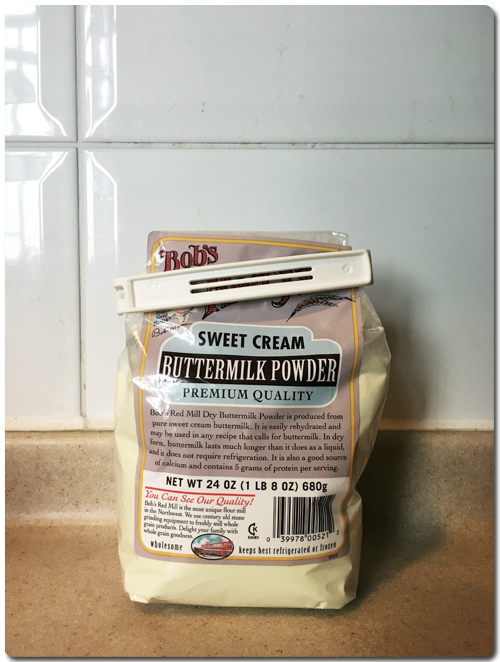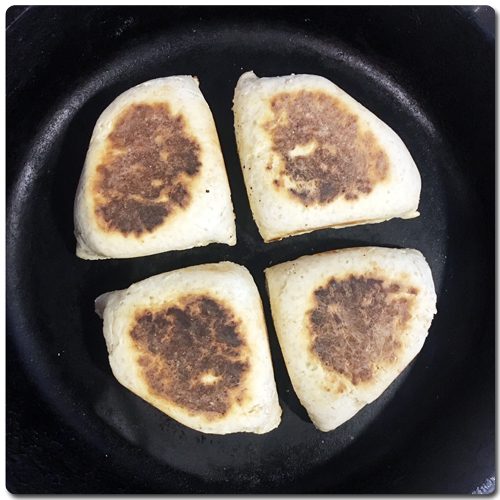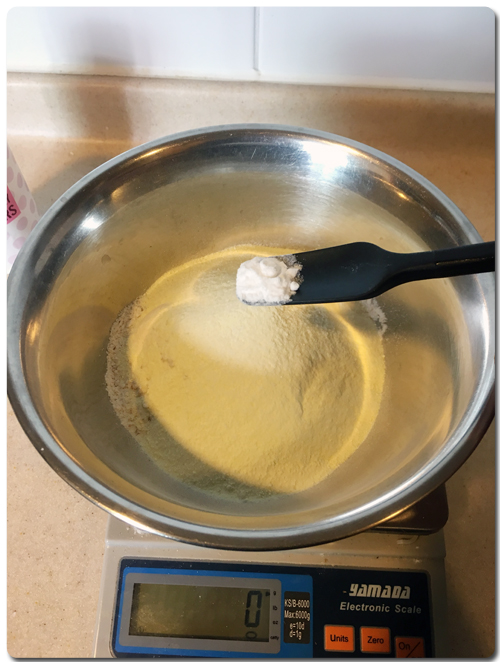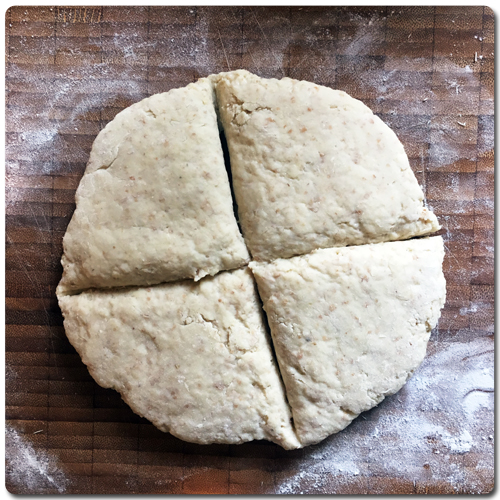Friday, March 17th, 2017...3:36 pm
Quicker than Quickbread: Irish Soda Farls

I have this weird habit. Okay, I have many, but there’s this one food/recipe related one in particular. Far more often than I’d like to admit, I get inexplicably obsessed with some random dish that I’ve never eaten or made before. It generally arises from something as inconsequential as a passing reference in a book or TV show, but “inconsequential” is not how I’d describe the subsequent number of hours devoted to googling recipes, historical significance, traditional vs modernist versions, and the like. Which wouldn’t be a bad thing if all that research actually resulted in me making the damn thing. Instead, what tends to happen is I’ll end up so confused by all the different regional variations, vast differences in recipe ratios (or lack of proper measurements), and, paralysed by the fact that I’ve never even eaten it before and therefore have no idea what it’s meant to actually look or taste or feel like, throw my hands up in despair and abandon the project. Because: where do I begin? How will I troubleshoot if something goes wrong? Will I even know if something goes wrong?
One of the things which I’d been torn between wanting to make but not daring to make for many, many years is Irish soda bread. On top of the obsessive googling, I’d intermittently harangue my one Irish friend about it (much to his confusion, I’m sure), peppering him with random trivia I’d gleaned from all sorts of questionable sources, in an attempt for verification. But the stakes just felt too high – especially considering my (then) relative inexperience with bread-baking, I was nowhere near confident enough to troubleshoot the average yeasted bread recipe, let alone this non-yeasted thing that I’d never tasted before? And so I’d reluctantly set it aside, at least until the next time some podcast or TV show reignited the googling-frenzy.

Which is why it (sort of) makes perfect sense that the only reason I’d ever make it was out of sheer desperation. I had run out of bread late last year, was impatiently waiting for my sourdough starter(s) to mature enough so I could attempt to bake some sourdough boules (and oh what a beautiful obsession that would turn out to be!), but I wanted bread. I wasn’t interested in the regular types of quickbreads that I have in my arsenal (banana bread, zucchini bread etc, both of which I view more as cakes than bread), 2-3 hours (the minimum time it’d take for a yeasted loaf to be ready) was too long, and I wasn’t in the mood for whatever I’d be able to find at the supermarkets in my neighbourhood. Thanks to said burgeoning sourdough habit, I also happened to have everything I needed to rustle up some soda bread on hand, thanks to a fortuitously timed discovery that city’super carries powdered buttermilk (which means I will never need to worry about what to do with the remainder of my quart carton when I want to make waffles).
While looking up a recipe, I chanced upon this Northern Irish variation – soda farls. “Farl” means “fourths”, and refers to any quadrant-shaped flatbread or cake that’s shaped by cutting a flattened disc into quarters. And this version of soda bread was simply cooked on a griddle, instead of in an oven, similar to English muffins. Said Irish friend explained to me that Northern Irish families were often too poor to own ovens, which is why the recipes might have been adapted for stovetop cooking. All I knew was that my quick bread recipe just got even quicker.

And, to my relief, it turned out delicious. I still have no idea if it even remotely resembles what gets made in Irish kitchens, and I’ve been chastised for mixing my white and whole meal flours, so this isn’t me trying to share the most authentic Irish grandmother’s version of soda farls. But! If you’ve got some buttermilk powder on hand, and you’re out of bread, I’ve got a solution for you. A chewy, delicious, satisfyingly dense solution, which comes together in under 15 minutes, does a great job at sopping up meaty stews, and, split and toasted, excels at being a delicious carby vehicle for getting ALL DAT BUTTER into your mouth. :)

I’ve since made it a few more times, tweaking the ratios of whole wheat to white flours for the flavour and texture that I’ve come to enjoy. But in terms of bakers percentages, I like around 15-20% whole grains for flavour and texture. I’ve read that oat flour is great for flavour and keeping the bread moist too, though I haven’t gotten my hands on any to try yet, but so far stoneground whole wheat and rye have both been delicious. Buttermilk powder (or at least, this brand of) is convenient and pretty tasty, but not particularly tangy, so I usually add a tiny splash of apple cider vinegar to the mix too – both for flavour and for the acidity which the baking soda needs to react with. So to all the Irish folk out there, I’m sorry if I’ve mangled your food culture, but thank you for this delicious trick which I’m happily keeping up my sleeve for all eternity, and Happy St Patrick’s Day!
PS: No, I still haven’t made the oven baked type of soda bread. :P
Sort of Irish Soda Farls
125g all purpose flour, plus extra for dusting
25g stoneground whole wheat flour (or replace with extra 25g AP flour)
50g buttermilk powder
1/2 tsp fine sea salt
1/2 tsp baking soda
about 100g filtered water
a few drops of apple cider vinegar, optional
Preheat a heavy based skillet (I like cast iron for this) over a low flame.
Combine flours, buttermilk powder, salt and baking soda in a medium mixing bowl. Stir to combine evenly, then make a well, and add about 90g of water to start. If desired, add a little apple cider vinegar (1/4 tsp is more than enough for this amount of dough), then gradually work the dry ingredients into the well to combine.

If the mixture seems very dry and like it won’t come together, add up to another 2 tbsp of water – I dribble it in a little at a time at the end, because I don’t like having to add too much more flour (since that throws off my macro calculations, and because it’s easier to incorporate water rather than dry flour into the dough). For the flours I use, 65-70% hydration has reliably worked out pretty well for me, but start on the lower end, and add just enough liquid so you get a thick, tacky dough.
Knead it briefly for 30-60 seconds in the bowl, then turn it out onto a lightly floured surface. Pat it into a round, flatten that into a disc that’s about 1cm thick. For this amount of flour, you’ll get a disc that’s maybe 15cm/6 inches in diameter, and if you decide to scale up, just pat or roll the disc out to around the same thickness so that the inside will be able to cook through before the outside gets too dark.

If your cast iron pan is not very well seasoned, lightly dust the surface with flour now. Using a bench knife, divide the disc into four quadrants, then place those in the preheated skillet, leaving about 1cm of space between the pieces as they will puff slightly. Cook for about 5-7 minutes per side, and they’re done when a metal skewer or thin blade inserted into the middle comes out clean. If you can, let them cool on a rack for 5-10 minutes before chowing down, but I split and buttered one of these babies fresh off the skillet and I was amazing. Serve immediately with a saucy stew, or split and butter. They allegedly keep great for a few days, especially if toasted, but when things come together in about as much time as it takes to boil water for pasta, I don’t really understand why you wouldn’t just make them fresh each day!
Yield: 4 fat little farls, which will serve 2-4, unless you’re me on training day in which case assume one person will demolish this entire batch before they’ve had time to cool.

Leave a Reply